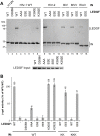A novel co-crystal structure affords the design of gain-of-function lentiviral integrase mutants in the presence of modified PSIP1/LEDGF/p75
- PMID: 19132083
- PMCID: PMC2606027
- DOI: 10.1371/journal.ppat.1000259
A novel co-crystal structure affords the design of gain-of-function lentiviral integrase mutants in the presence of modified PSIP1/LEDGF/p75
Abstract
Lens epithelium derived growth factor (LEDGF), also known as PC4 and SFRS1 interacting protein 1 (PSIP1) and transcriptional co-activator p75, is the cellular binding partner of lentiviral integrase (IN) proteins. LEDGF accounts for the characteristic propensity of Lentivirus to integrate within active transcription units and is required for efficient viral replication. We now present a crystal structure containing the N-terminal and catalytic core domains (NTD and CCD) of HIV-2 IN in complex with the IN binding domain (IBD) of LEDGF. The structure extends the known IN-LEDGF interface, elucidating primarily charge-charge interactions between the NTD of IN and the IBD. A constellation of acidic residues on the NTD is characteristic of lentiviral INs, and mutations of the positively charged residues on the IBD severely affect interaction with all lentiviral INs tested. We show that the novel NTD-IBD contacts are critical for stimulation of concerted lentiviral DNA integration by LEDGF in vitro and for its function during the early steps of HIV-1 replication. Furthermore, the new structural details enabled us to engineer a mutant of HIV-1 IN that primarily functions only when presented with a complementary LEDGF mutant. These findings provide structural basis for the high affinity lentiviral IN-LEDGF interaction and pave the way for development of LEDGF-based targeting technologies for gene therapy.
Conflict of interest statement
The authors have declared that no competing interests exist.
Figures





References
-
- Lewinski MK, Bushman FD. Retroviral DNA integration–mechanism and consequences. Adv Genet. 2005;55:147–181. - PubMed
-
- Craigie R. Retroviral DNA Integration. In: Craig NL, Craigie R, Gellert M, Lambowitz AM, editors. Mobile DNA II. Washington DC: ASM Press; 2002. pp. 613–630.
Publication types
MeSH terms
Substances
Grants and funding
LinkOut - more resources
Full Text Sources
Other Literature Sources
Research Materials

